seats MERCEDES-BENZ E-CLASS COUPE 2018 Owner's Manual
[x] Cancel search | Manufacturer: MERCEDES-BENZ, Model Year: 2018, Model line: E-CLASS COUPE, Model: MERCEDES-BENZ E-CLASS COUPE 2018Pages: 486, PDF Size: 6.31 MB
Page 4 of 486
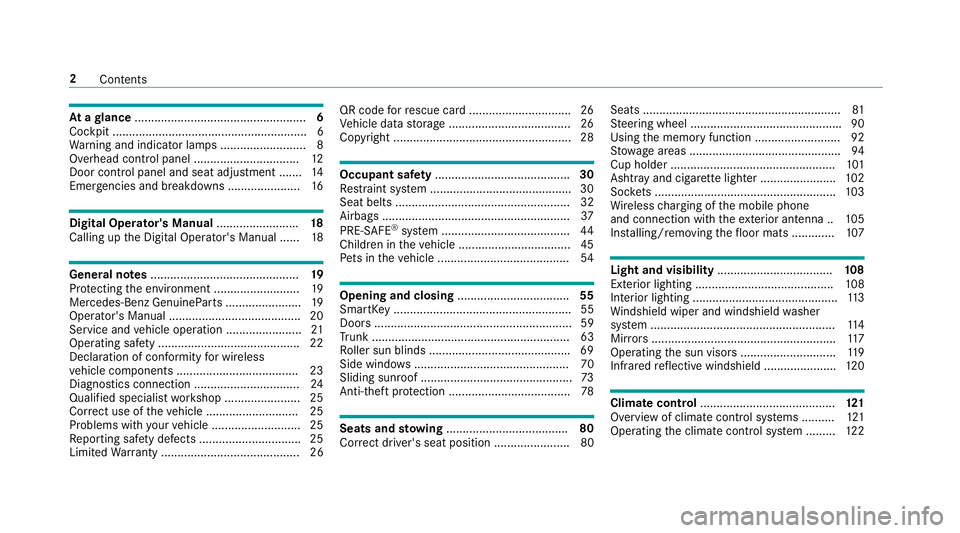
Atagl ance .................................................... 6
Cockpit ........................................................... 6
Wa rning and indicator lamps .......................... 8
Overhead control panel ................................ 12
Door control panel and seat adjustment ....... 14
Emergencies and breakdowns ...................... 16
DigitalOperator' sManua l........................ .18
Callin g upthe Digital Operator's Manual ...... 18
General notes............................................. 19
Pr otecting the environment .......................... 19
Mercedes-Benz GenuineParts ....................... 19
Operator's Manual ........................................2 0
Service and vehicle operation ....................... 21
Operating saf ety.......................................... .22
Declaration of conformity for wireless
ve hicle components .....................................2 3
Diagnost ics connection ................................ 24
Qualified specialist workshop ....................... 25
Cor rect use of theve hicle ............................2 5
Problems with your vehicle ........................... 25
Re porting saf etydefects .............................. .25
Limited Warranty .......................................... 26 QR code
forre scue card ...............................2 6
Ve hicle data storage .....................................2 6
Copyright .. .................................................... 28
Occupant safety......................................... 30
Re stra int sy stem .......................................... .30
Seat belts ..................................................... 32
Airbags ......................................................... 37
PRE-SAFE
®sy stem ....................................... 44
Childr en intheve hicle ..................................4 5
Pe ts in theve hicle ........................................5 4
Opening and closing.................................. 55
SmartK ey...................................................... 55
Doors ............................................................ 59
Tr unk ............................................................ 63
Ro ller sun blinds .......................................... .69
Side windo ws............................................... 70
Sliding sunroof .............................................. 73
Anti-theft pr otection .................................... .78
Seats and stowing .................................... .80
Cor rect driver's seat position ....................... 80 Seats ............................................................
81
St eering wheel ............................................. .90
Using the memory function .......................... 92
St ow age areas .............................................. 94
Cup holder .................................................. 101
Ashtr ayand cigar ette lighter ...................... .102
Soc kets ....................................................... 103
Wi reless charging of the mobile phone
and connection with theex terior antenna .. 105
Ins talling/ removing thefloor mats .............1 07
Light and visibility................................... 108
Exterior lighting .......................................... 108
Interior lighting ............................................ 113
Wi ndshield wiper and windshield washer
sy stem ........................................................ 114
Mir rors ........................................................ 117
Operating the sun visors ............................. 119
Infrared reflective windshield ..................... .120
Climate control ......................................... 121
Overview of climate cont rol sy stems ......... .121
Operating the climate control sy stem ......... 122
2
Conte nts
Page 17 of 486
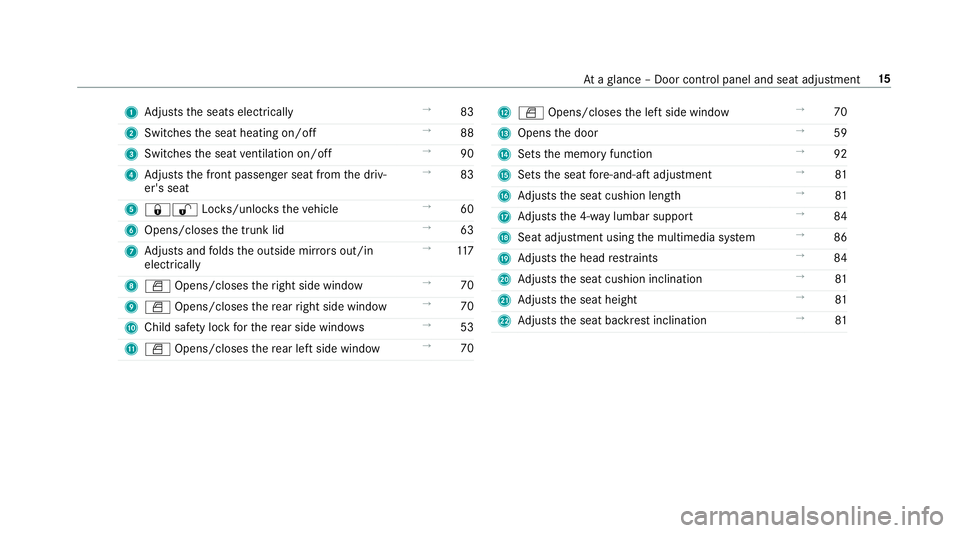
1Adjusts the seats electrically →
83
2 Switches the seat heating on/off →
88
3 Switches the seat ventilation on/off →
90
4 Adjusts the front passenger seat from the driv‐
er's seat →
83
5 &% Locks/unloc kstheve hicle →
60
6 Opens/closes the trunk lid →
63
7 Adjusts and folds the outside mir rors out/in
electrically →
117
8 W Opens/closes theright side window →
70
9 W Opens/closes there ar right side window →
70
A Child saf etyloc kfo rth ere ar side wind ows →
53
B W Opens/closes there ar left side wind ow→
70CW Opens/closes the left side window →
70
D Opens the door →
59
E Sets the memory function →
92
F Sets the seat fore -and-aft adjustment →
81
G Adjusts the seat cushion length →
81
H Adjusts the 4-w aylumbar support →
84
I Seat adjustment using the multimedia sy stem →
86
J Adjusts the head restra ints →
84
K Adjusts the seat cushion inclination →
81
L Adjusts the seat height →
81
M Adjusts the seat backrest inclination →
81
Ataglance – Door control panel and seat adjustment 15
Page 22 of 486
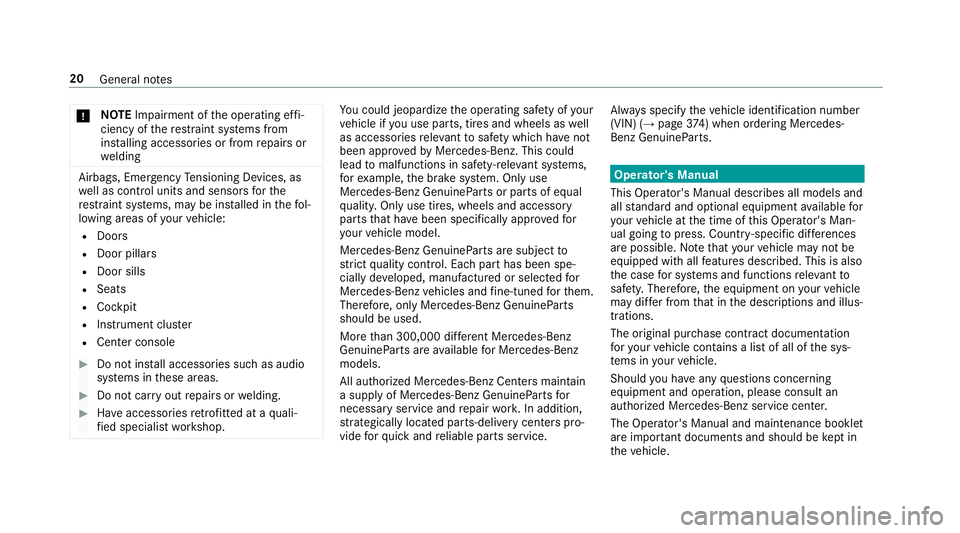
*NO
TEImpairment of the operating ef fi‐
ciency of there stra int sy stems from
ins talling accessories or from repairs or
we lding
Airbags, Emer gency Tensioning Devices, as
we ll as control units and sensors forth e
re stra int sy stems, may be ins talled in thefo l‐
lowing areas of your vehicle:
RDoors
RDoor pillars
RDoor sills
RSeats
RCo ckpit
RInstrument clus ter
RCente r console
#Do not ins tall accessories such as audio
sy stems in these areas.
#Do not car ryout repairs or welding.
#Have accessori esretrofitted at a quali‐
fi ed specialist workshop.
Yo u could jeopardize the operating saf etyof your
ve hicle if you use parts, tires and wheels as well
as accessories releva nt tosaf etywhic hha ve not
been appr ovedby Mercedes-Benz. This could
lead tomalfunctions in saf ety-re leva nt sy stems,
fo rex ample, the brake sy stem. Only use
Mercedes-Benz GenuineParts or parts of equal
qu ality. Only use tires, wheels and accessory
parts that ha vebeen specifically appr ovedfo r
yo ur vehicle model.
Mercedes-Benz GenuineParts are subject to
st rict quality control. Each part has been spe‐
cially de veloped, manufactured or selecte dfo r
Mercedes-Benz vehicles and fine-tuned forth em.
Therefore, only Mercedes-Benz GenuineParts
should be used.
More than 300,000 dif fere nt Mercedes-Benz
GenuineParts are available for Mercedes-Benz
models.
All au thorized Mercedes-Benz Centers maintain
a supply of Mercedes-Benz GenuineParts for
necessary service and repair work. In addition,
st ra tegically located parts-delivery centers pro‐
vide forqu ick and reliable parts service. Alw
ays specify theve hicle identification number
(VIN) (→page 374) when ordering Mercedes-
Benz GenuineParts.
Operator's Manual
This Operator's Manual describes all models and
all standard and optional equipment available for
yo ur vehicle at the time of this Opera tor's Man‐
ual going topress. Countr y-specific dif fere nces
are possible. No tethat your vehicle may not be
equipped with all features descri bed. This is also
th e case for sy stems and functions releva nt to
saf ety. Therefore, the equipment on your vehicle
may dif fer from that in the descriptions and illus‐
trations.
The original pur chase contract documentation
fo ryo ur vehicle contains a list of all of the sys‐
te ms in your vehicle.
Should you ha veany questions concerning
equipment and operation, please consult an
authorized Mercedes-Benz service center.
The Operator's Manual and maintenance booklet
are impor tant documents and should be kept in
th eve hicle.
20
General no tes
Page 35 of 486
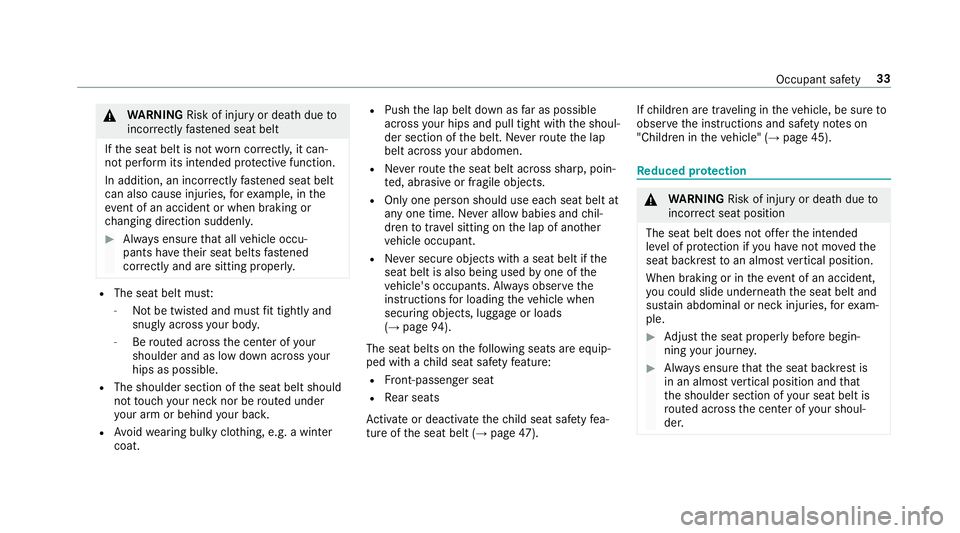
&WARNING Risk of injury or death dueto
incor rectly fastened seat belt
If th e seat belt is not worncor rectly, it can‐
not per form its intended pr otective function.
In addition, an incor rectly fastened seat belt
can also cause injuries, forex ample, in the
ev ent of an accident or when braking or
ch anging direction suddenly .
#Always ensure that all vehicle occu‐
pants ha vetheir seat belts fastened
cor rectly and are sitting prope rly.
RThe seat belt mus t:
-Not be twisted and must fit tightly and
snugl yacross your body .
-Berouted across the center of your
shoulder and as low down across your
hips as possible.
RThe shoulder section of the seat belt should
not touch your ne cknor be routed under
yo ur arm or behind your bac k.
RAvoid wearing bulky clo thing, e.g. a winter
coat.
RPush the lap belt down as far as possible
across your hips and pull tight withth e shoul‐
der section of the belt. Ne verro ute the lap
belt across your abdomen.
RNe verro ute the seat belt across sharp, poin‐
te d, abrasive or fragile objects.
ROnly one person should use each seat belt at
any one time. Ne ver all owbabies and chil‐
dren totrave l sitting on the lap of ano ther
ve hicle occupant.
RNe ver secure objects with a seat belt if the
seat belt is also being used byone of the
ve hicle's occupants. Alw ays obser vethe
instructions for loading theve hicle when
securing objects, luggage or loads
(
→page 94).
The seat belts on thefo llowing seats are equip‐
ped with a child seat saf etyfe ature:
RFr ont-passenger seat
RRe ar seats
Ac tivate or deacti vate thech ild seat saf etyfe a‐
ture of the seat belt (
→page 47). If
ch ildren are tra veling in theve hicle, be sure to
obser vethe instructions and saf
etyno tes on
"Children in theve hicle" (
→page 45).
Re duced pr otection
&
WARNING Risk of injury or death dueto
incor rect seat position
The seat belt does not of ferth e intended
le ve l of pr otection if you ha venot mo vedth e
seat backrest toan almost vertical position.
When braking or in theeve nt of an accident,
yo u could slide underneath the seat belt and
sus tain abdominal or neck injuries, forex am‐
ple.
#Ad just the seat proper lybefore begin‐
ning your journe y.
#Always ensure that the seat backrest is
in an almost vertical position and that
th e shoulder section of your seat belt is
ro uted across the center of your shoul‐
der.
Occupant saf ety 33
Page 41 of 486
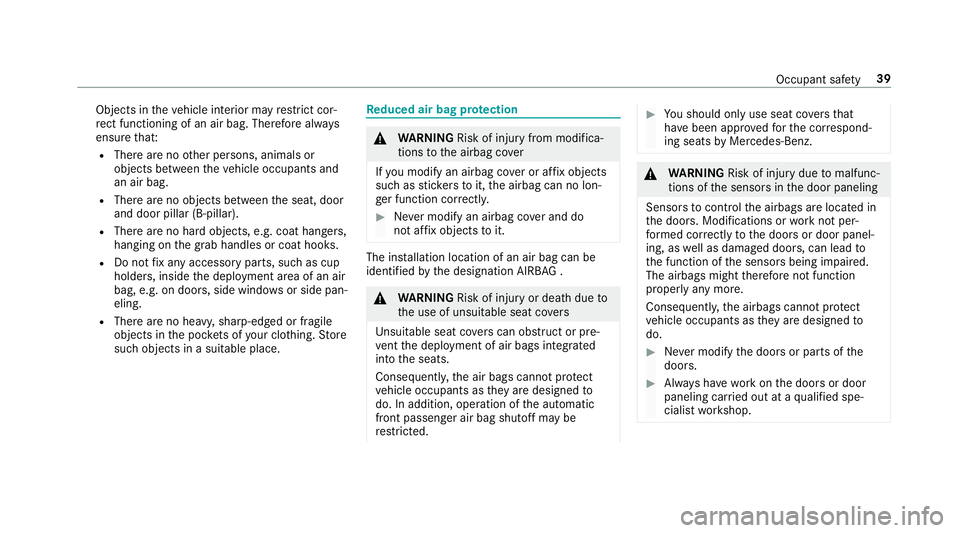
Objects intheve hicle interior may restrict cor‐
re ct functioning of an air bag. There fore alw ays
ensure that:
RThere are no other persons, animals or
objects between theve hicle occupants and
an air bag.
RThere are no objects between the seat, door
and door pillar (B-pillar).
RThere are no hard objects, e.g. coat hangers,
hanging on the grab handles or coat hooks.
RDo not fix any accessory parts, such as cup
holders, inside the deployment area of an air
bag, e.g. on doors, side windo wsor side pan‐
eling.
RThere are no heavy, sharp-edged or fragile
objects in the poc kets of your clo thing. Store
such objects in a suitable place.
Re duced air bag pr otection
&
WARNING Risk of injury from modifica‐
tions tothe airbag co ver
If yo u modify an airbag co ver or af fix objects
such assticke rs to it,the airbag can no lon‐
ge r function cor rectl y.
#Ne ver modify an airbag co ver and do
not af fix objects toit.
The ins tallation location of an air bag can be
identified bythe designation AIRB AG.
&
WARNING Risk of injury or death dueto
th e use of unsuitable seat co vers
Uns uitable seat co vers can obstruct or pre‐
ve nt the deployment of air bags integrated
into the seats.
Consequentl y,the air bags cannot protect
ve hicle occupants as they are designed to
do. In addition, operation of the automatic
front passenger air bag shutoff may be
re stricted.
#Yo u should only use seat covers that
ha ve been appr oved forth e cor respond‐
ing seats byMercedes-Benz.
&
WARNING Risk of injury duetomalfunc‐
tions of the sensors in the door paneling
Sensors tocontrol the airbags are located in
th e doors. Modifications or worknot per‐
fo rm ed cor rectly tothe doors or door panel‐
ing, as well as damaged doors, can lead to
th e function of the sensors being impaired.
The airbags might therefore not function
proper lyany more.
Consequent ly,th e airbags cannot protect
ve hicle occupants as they are designed to
do.
#Ne ver modify the doors or parts of the
doors.
#Alw ays ha vewo rkon the doors or door
paneling car ried out at a qualified spe‐
cialist workshop.
Occupant saf ety 39
Page 50 of 486
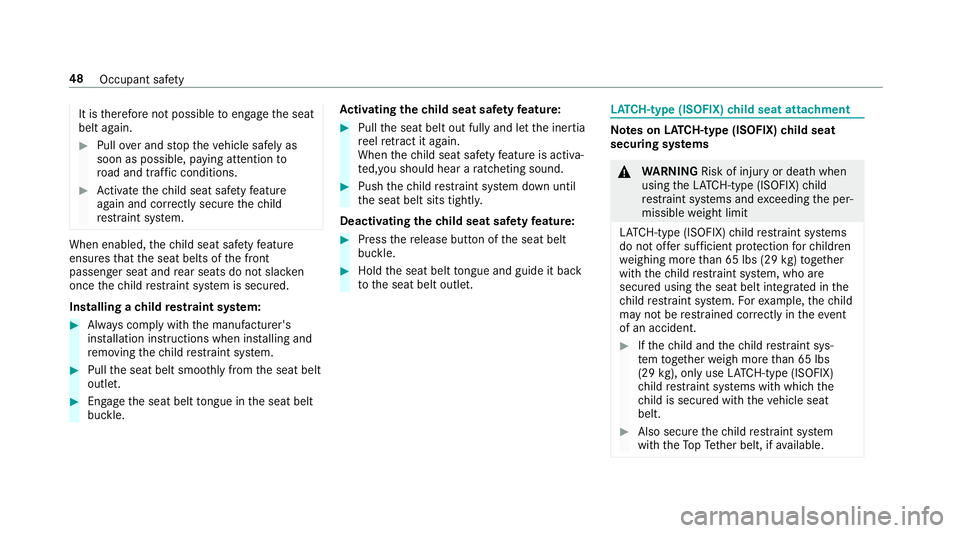
It istherefore not possible toengage the seat
belt again.
#Pull over and stop theve hicle safely as
soon as possible, paying attention to
ro ad and traf fic conditions.
#Ac tivate thech ild seat saf etyfe ature
again and cor rectly secure thech ild
re stra int sy stem.
When enabled, thech ild seat saf etyfe ature
ensures that the seat belts of the front
passenger seat and rear seats do not slac ken
once thech ild restra int sy stem is secured.
Installing a child restra int sy stem:
#Alw ays comply with the manufacturer's
ins tallation instructions when ins talling and
re moving thech ild restra int sy stem.
#Pull the seat belt smoo thly from the seat belt
outlet.
#En gage the seat belt tongue in the seat belt
buckle. Ac
tivating the child seat saf etyfe ature:
#Pull the seat belt out fully and let the inertia
re el retract it again.
When thech ild seat saf etyfe ature is activa‐
te d,you should hear a ratcheting sound.
#Push thech ild restra int sy stem down until
th e seat belt sits tightly.
Deactivating the child seat saf etyfe ature:
#Press there lease button of the seat belt
buckle.
#Hold the seat belt tongue and guide it ba ck
to the seat belt outlet.
LA TC H-type (ISOFIX) child seat attachment
Note s onLATC H-type (ISOFIX) child seat
securing sy stems
&
WARNING Risk of injury or death when
using theLA TC H-type (ISOFIX) child
re stra int sy stems and exceeding the per‐
missible weight limit
LA TC H-type (ISOFIX) child restra int sy stems
do not of fer suf ficient pr otection forch ildren
we ighing more than 65 lbs (29 kg)to ge ther
with thech ild restra int sy stem, who are
secured using the seat belt integrated in the
ch ild restra int sy stem. Forex ample, thech ild
may not be restra ined cor rectly in theeve nt
of an accident.
#If th ech ild and thech ild restra int sys‐
te m toget her weigh more than 65 lbs
(29 kg),only use LATC H-type (ISOFIX)
ch ild restra int sy stems with which the
ch ild is secured with theve hicle seat
belt.
#Also secure thech ild restra int sy stem
with theTo pTe ther belt, if available.
48
Occupant saf ety
Page 54 of 486
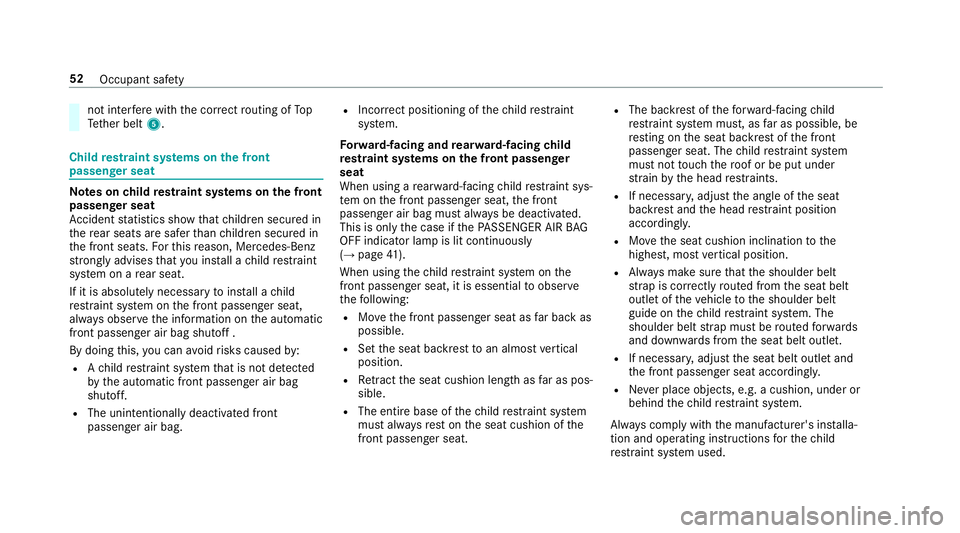
not interfere with the cor rect routing of Top
Te ther belt 5.
Childrestra int sy stems on the front
passenger seat
Note s onchild restra int sy stems on the front
passenger seat
Ac cident statistics show that children secured in
th ere ar seats are safer than children secured in
th e front seats. Forth is reason, Mercedes-Benz
stro ngly advises that you ins tall a child restra int
sy stem on a rear seat.
If it is absolutely necessary toins tall a child
re stra int sy stem on the front passenger seat,
alw ays obser vethe information on the automatic
front passenger air bag shutoff .
By doing this, you can avoidrisks caused by:
RAch ild restra int sy stem that is not de tected
by the automatic front passenger air bag
shutoff.
RThe unintentionally deactivated front
passenger air bag.
RIncor rect positioning of thech ild restra int
sy stem.
Fo rw ard-facing and rear wa rd-facing child
re stra int sy stems on the front passenger
seat
When using a rear wa rd-f acing child restra int sys‐
te m on the front passenger seat, the front
passenger air bag must alw ays be deactivated.
This is only the case if thePA SSENGER AIR BAG
OFF indicator lamp is lit continuously
(
→page 41).
When usingthech ild restra int sy stem on the
front passenger seat, it is essential toobser ve
th efo llowing:
RMo vethe front passenger seat as far back as
possible.
RSet the seat backrest toan almost vertical
position.
RRe tract the seat cushion length as far as pos‐
sible.
RThe entire base of thech ild restra int sy stem
must alw aysre st on the seat cushion of the
front passenger seat.
RThe backrest of thefo rw ard-facing child
re stra int sy stem must, as far as possible, be
re sting on the seat backrest of the front
passenger seat. The child restra int sy stem
must not touch thero of or be put under
st ra in by the head restra ints.
RIf necessar y,adjust the angle of the seat
backrest and the head restra int position
according ly.
RMo vethe seat cushion inclination tothe
highest, most vertical position.
RAlw ays make sure that the shoulder belt
st ra p is cor rectly routed from the seat belt
outlet of theve hicle tothe shoulder belt
guide on thech ild restra int sy stem. The
shoulder belt stra p must be routed forw ards
and down wards from the seat belt outlet.
RIf necessar y,adjust the seat belt outlet and
th e front passenger seat accordingly.
RNe ver place objects, e.g. a cushion, under or
behind thech ild restra int sy stem.
Alw ays comply with the manufacturer's ins talla‐
tion and operating instructions forth ech ild
re stra int sy stem used.
52
Occupant saf ety
Page 82 of 486
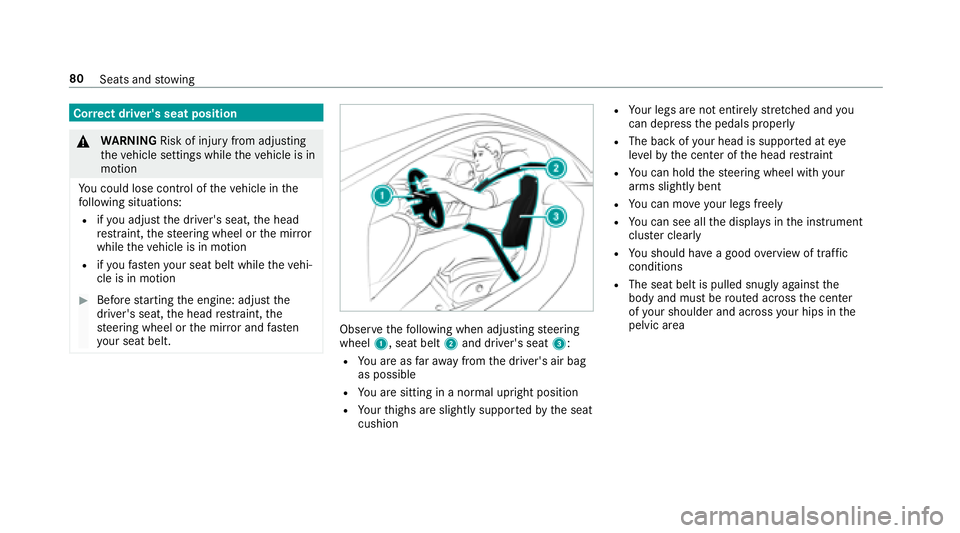
Correct driver's seat position
&
WARNING Risk of injury from adjusting
th eve hicle settings while theve hicle is in
motion
Yo u could lose cont rol of theve hicle in the
fo llowing situations:
Rifyo u adjust the driver's seat, the head
re stra int, thesteering wheel or the mir ror
while theve hicle is in motion
Rifyo ufa sten your seat belt while theve hi‐
cle is in motion
#Before starting the engine: adjust the
driver's seat, the head restra int, the
st eering wheel or the mir ror and fasten
yo ur seat belt.
Obser vethefo llowing when adjusting steering
wheel 1, seat belt 2and driver's seat 3:
RYou are as faraw ay from the driver's air bag
as possible
RYo u are sitting in a no rmal upright position
RYour thighs are slightly supportedby the seat
cushion
RYo ur legs are not entirely stre tched and you
can dep ress the pedals properly
RThe back of your head is support ed ateye
le ve lby the center of the head restra int
RYo u can hold thesteering wheel with your
arms slightly bent
RYo u can mo veyour legs freely
RYo u can see all the displa ysinthe instrument
clus ter clearl y
RYou should ha vea good overview of traf fic
conditions
RThe seat belt is pulled snug lyagainst the
body and must be routed across the center
of your shoulder and across your hips in the
pelvic area
80 Seats and stowing
Page 83 of 486
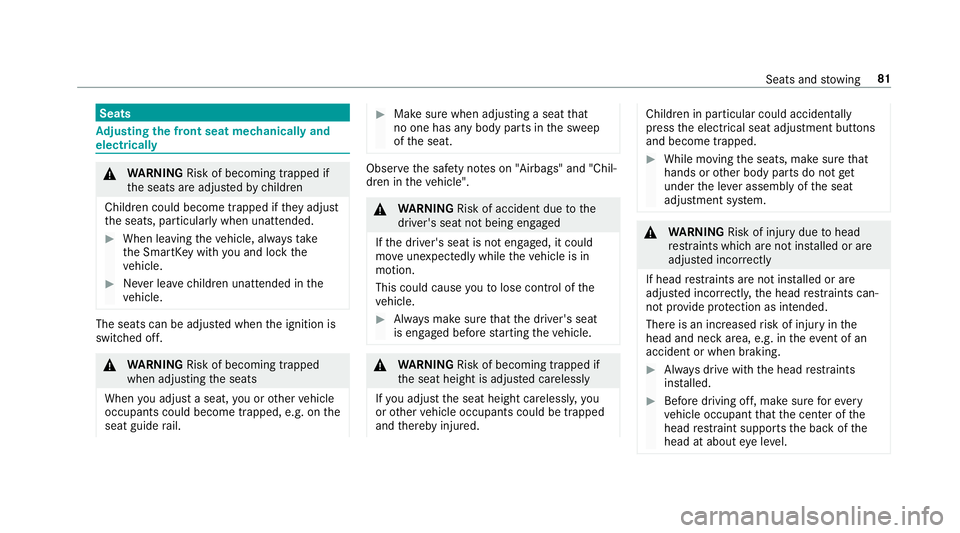
Seats
Adjusting the front seat mechanically and
electrically
& WARNING Risk of becoming trapped if
th e seats are adjus tedby children
Children could become trapped if they adjust
th e seats, particularly when unattended.
#When leaving theve hicle, alw aysta ke
th e SmartK eywith you and lock the
ve hicle.
#Ne ver lea vechildren unatte nded inthe
ve hicle.
The seats can be adjus ted when the ignition is
switched off.
& WARNING Risk of becoming trapped
when adjusting the seats
When you adjust a seat, you or other vehicle
occupants could become trapped, e.g. on the
seat guide rail.
#Make sure when adjusting a seat that
no one has any body parts in the sweep
of the seat.
Obser vethe saf etyno tes on "Airbags" and "Chil‐
dren in theve hicle".
&
WARNING Risk of accident due tothe
driver's seat not being engaged
If th e driver's seat is not engaged, it could
mo veunexpectedly while theve hicle is in
motion.
This could cause youto lose control of the
ve hicle.
#Alw ays make sure that the driver's seat
is engaged before starting theve hicle.
&
WARNING Risk of becoming trapped if
th e seat height is adjus ted carelessly
If yo u adjust the seat height carelessly, you
or other vehicle occupants could be trapped
and thereby injured.
Children in particular could accidenta lly
press the electrical seat adjustment buttons
and become trapped.
#While moving the seats, make sure that
hands or other body parts do not get
under the le ver assembly of the seat
adjustment sy stem.
&
WARNING Risk of injury duetohead
re stra ints which are not ins talled or are
adjus ted incor rectly
If head restra ints are not ins talled or are
adjus ted incor rectly, the head restra ints can‐
not pr ovide pr otection as intended.
There is an increased risk of injury in the
head and neck area, e.g. in theeve nt of an
accident or when braking.
#Alw ays drive with the head restra ints
ins talled.
#Before driving off, make sure forev ery
ve hicle occupant that the center of the
head restra int supports the back of the
head at about eye le vel.
Seats and stowing 81
Page 84 of 486
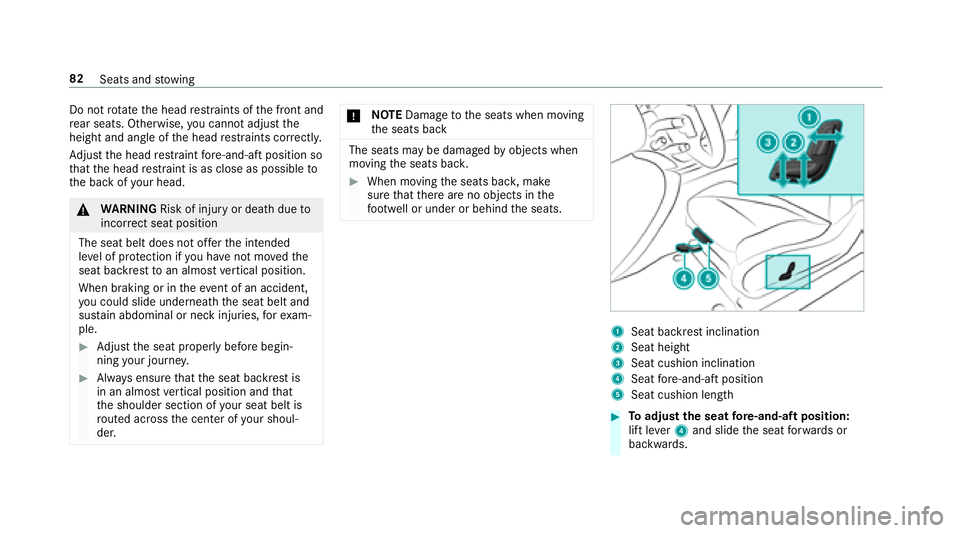
Do notrotate the head restra ints of the front and
re ar seats. Otherwise, you cannot adjust the
height and angle of the head restra ints cor rectl y.
Ad just the head restra int fore -and-aft position so
th at the head restra int is as close as possible to
th e back of your head.
&
WARNING Risk of injury or death dueto
incor rect seat position
The seat belt does not of ferth e intended
le ve l of pr otection if you ha venot mo vedth e
seat backrest toan almost vertical position.
When braking or in theeve nt of an accident,
yo u could slideunderneath the seat belt and
sus tain abdominal or neck injuries, forex am‐
ple.
#Ad just the seat proper lybefore begin‐
ning your journe y.
#Always ensure that the seat backrest is
in an almost vertical position and that
th e shoulder section of your seat belt is
ro uted across the center of your shoul‐
der.
* NO
TEDama getothe seats when moving
th e seats back
The seats may be damaged byobjects when
moving the seats bac k.
#When moving the seats bac k,make
sure that there are no objects in the
fo ot we ll or under or behind the seats.
1Seat backrest inclination
2Seat height
3Seat cushion inclination
4Seat fore -and-aft position
5Seat cushion length
#To adjust the seat fore -and-aft position:
lift le ver4 and slide the seat forw ards or
backwards.
82 Seats and stowing